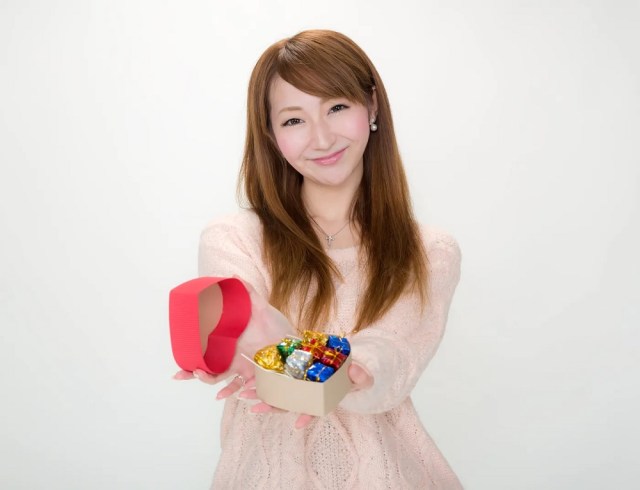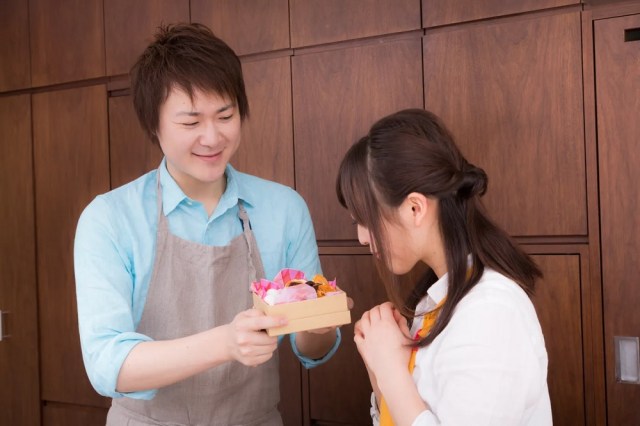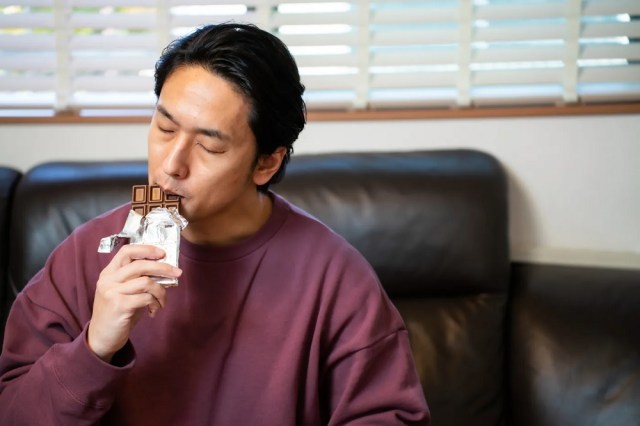
There’s more to Valentine’s chocolate in Japan than the infamous “obligation” type.
Every year when Valentine’s Day rolls around, you’ll hear a lot of talk about giri choco, or “obligation chocolate.” In Japan, it’s women who give gifts to men for Valentine’s Day, and giri choco is the chocolate given to platonic male co-workers as a general-purpose thank-you for any incidental help in day-to-day office life.
Giri choco isn’t the only class of Valentine’s Day sweets presents with its own name, though, so today, let’s take a look at some of the others with an assorted sampler of Japanese vocabulary.
1. Giri choco: “obligation chocolate” (kind of)
But first, let’s take another look at the meaning of giri choco. The Japanese word giri can translate as “obligation,” and that definitely feels like the right rendering when talking about giri choco in the sense of it being an annual hassle for a lot of Japanese women. That said, giri, which can also translate as “duty,” can be used in the connotation of “doing right by somebody” or otherwise showing someone legitimately due courtesy, so “giri choco” doesn’t always carry quite the oppressive weight that “obligation” does in English, which ties in to how the practice isn’t something that everyone hates all the time.
2. Honmei choco: “favorite chocolate”
That’s “favorite” as in the likely winner or most probable candidate. Honmei choco is chocolate that a woman gives to the guy she has genuine romantic feelings for, such as her boyfriend, husband, or the object of her not-yet-confessed-but-hopefully-soon-to-be-requited affection.
3. Tomo choco: “friend chocolate”
For a long time, honmei and giri were pretty much the only two major kinds of Valentine’s Day chocolate in Japan. But as women were browsing through store selections, picking out economically priced giri choco and fancier honmei choco, some of them also started picking up some sweets to give to their female friends. Thus was born tomo choco (from tomodachi/friend), letting girls enjoy being on the receiving end of Valentine’s Day chocolate presents.
4. Jibun choco: “self chocolate”
And hey, if you’re already at the store to buy chocolate for your boyfriend, girlfriends, and coworkers, why not treat yourself to something too? Those self-bought, self-given, and, most importantly, self-eaten sweets are known as jibun choco (jibun meaning “one’s self”).
5. Kazoku choco: “family chocolate”
Originally, Valentine’s Day was primarily something only the young and cosmopolitan celebrated in Japan. As time’s gone by, though, it’s become something that young and old, city dwellers and country folk alike look forward to. Initially, intra-family chocolate gifting was pretty much only wives and daughters giving chocolate to the household dad, but now some women give chocolate to other members of their family (kazoku) too.
6. Gyaku choco: “reverse chocolate”
You’ll notice that so far we’ve only talked about women giving chocolate. That’s because Japan has a separate day, White Day on March 14, when men give thank-you gifts back to the women who gave them Valentine’s Day chocolate. There are some guys in Japan, though, who give chocolate to women on Valentine’s Day, which is called gyaku chocolate (gyaku meaning “reverse”). Since it’s not the norm, giving gyaku choco has a high chance of delivering a genuine surprise, and with the selection of chocolate in stores being bigger at Valentine’s Day than White Day, gyaku choco also lets you choose some extra-special sweets.
7. Ore choco: “my chocolate”
“Hey, wait a second! We already covered giving chocolate to yourself. You said it’s called ‘jibun choco!’”
First, let me compliment you on how quickly you retained that vocabulary, but ore choco is different from jibun choco, though. Ore means “I,” so in a lot of ways it’s interchangeable with jibun/one’s self. The key difference, though, is that ore is a very masculine way of speaking, and so ore choco is Valentine’s Day chocolate that a guy buys for himself. Maybe he’s single and not expecting any chocolate from the ladies in his social circle, or maybe he just found some limited-time chocolates he really wants to eat, and doesn’t want to leave things up to chance by keeping his fingers crossed that his girlfriend happens to pick those exact ones to give to him.
As Japanese society and language evolves, we’ll probably start seeing even more words to describe different kinds of Valentine’s Day chocolate. For now, though, it’s a good reminder that there’s no wrong way to celebrate as long as it leaves a sweet flavor on your taste buds and a happy feeling in your heart.
Top image: Pakutaso
Insert images: Pakutaso (1, 2, 3, 4)
● Want to hear about SoraNews24’s latest articles as soon as they’re published? Follow us on Facebook and Twitter!
Follow Casey on Twitter, where he’s always hungry for/in love with linguistics.





 This Valentine’s Day, tell him you don’t love him with Japanese women’s “chocolate maggot” recipe
This Valentine’s Day, tell him you don’t love him with Japanese women’s “chocolate maggot” recipe In Japan, women give “obligation chocolate” on Valentine’s Day, but do guys even want it?
In Japan, women give “obligation chocolate” on Valentine’s Day, but do guys even want it? Only one demographic in survey is happy about Japan’s workplace obligation Valentine’s chocolate
Only one demographic in survey is happy about Japan’s workplace obligation Valentine’s chocolate Godiva runs full-page ad asking Japanese women to stop buying so much Valentine’s chocolate
Godiva runs full-page ad asking Japanese women to stop buying so much Valentine’s chocolate Survey shows Japanese women would love to be getting some chocolate on Valentine’s Day too
Survey shows Japanese women would love to be getting some chocolate on Valentine’s Day too Japan’s new difficult-to-drink-from beer glass protects your liver, but it’s a brutal experience
Japan’s new difficult-to-drink-from beer glass protects your liver, but it’s a brutal experience How to order snacks on a Shinkansen bullet train in Japan
How to order snacks on a Shinkansen bullet train in Japan New samurai glasses are Japan’s latest weird must-have souvenir
New samurai glasses are Japan’s latest weird must-have souvenir New Pokémon ice cream, dessert drinks, and cool merch coming to Baskin-Robbins Japan【Pics】
New Pokémon ice cream, dessert drinks, and cool merch coming to Baskin-Robbins Japan【Pics】 Doraemon found buried at sea as scene from 1993 anime becomes real life【Photos】
Doraemon found buried at sea as scene from 1993 anime becomes real life【Photos】 Burger King Japan suddenly adds Dr. Pepper and Dr. Pepper floats to its menu nationwide
Burger King Japan suddenly adds Dr. Pepper and Dr. Pepper floats to its menu nationwide Starbucks Japan welcomes alpacas for cute summer drinkware line【Photos】
Starbucks Japan welcomes alpacas for cute summer drinkware line【Photos】 High-fashion Totoro cuddle purse is like an elegant stroll in the forest【Photos】
High-fashion Totoro cuddle purse is like an elegant stroll in the forest【Photos】 Studio Ghibli hair accessories keep your style tidy with help from Kiki, Moro, Calcifer, and more
Studio Ghibli hair accessories keep your style tidy with help from Kiki, Moro, Calcifer, and more What if Sailor Moon characters were lingerie models? They’d look stunning like this 【Photos】
What if Sailor Moon characters were lingerie models? They’d look stunning like this 【Photos】 Nintendo history you can feel – Super NES, N64, and GameCube controllers become capsule toys
Nintendo history you can feel – Super NES, N64, and GameCube controllers become capsule toys Hello, cosmetics! Clinique teams up with Hello Kitty this summer for first-time collaboration
Hello, cosmetics! Clinique teams up with Hello Kitty this summer for first-time collaboration Demon Slayer: Kimetsu no Yaiba gets new roller coaster attractions and food at Universal Studios Japan
Demon Slayer: Kimetsu no Yaiba gets new roller coaster attractions and food at Universal Studios Japan “The most Delicious Cup Noodle in history” – Japan’s French Cup Noodle wins our heart【Taste test】
“The most Delicious Cup Noodle in history” – Japan’s French Cup Noodle wins our heart【Taste test】 Starbucks releases a cute Frappuccino and Unicorn Cake…but not in Japan
Starbucks releases a cute Frappuccino and Unicorn Cake…but not in Japan Kyoto Tower mascot termination reveals dark side behind cute Japanese characters
Kyoto Tower mascot termination reveals dark side behind cute Japanese characters McDonald’s Japan’s Soft Twist Tower: A phantom ice cream only sold at select branches
McDonald’s Japan’s Soft Twist Tower: A phantom ice cream only sold at select branches Yabai Ramen: What makes this Japanese ramen so dangerous?
Yabai Ramen: What makes this Japanese ramen so dangerous? Finally! Nintendo Japan expands Switch 8-bit controller sales to everybody, Online member or not
Finally! Nintendo Japan expands Switch 8-bit controller sales to everybody, Online member or not Japanese government wants to build luxury resorts in all national parks for foreign tourists
Japanese government wants to build luxury resorts in all national parks for foreign tourists To combat declining birth rate, Japan to begin offering “Breeding Visas” to foreigners
To combat declining birth rate, Japan to begin offering “Breeding Visas” to foreigners 10 things you should buy at 7-Eleven in Japan
10 things you should buy at 7-Eleven in Japan Studio Ghibli releases anime heroine cosplay dresses that are super comfy to wear
Studio Ghibli releases anime heroine cosplay dresses that are super comfy to wear Woman charged for driving suitcase without a license in Osaka
Woman charged for driving suitcase without a license in Osaka Studio Ghibli unveils My Neighbour Totoro miniature house model
Studio Ghibli unveils My Neighbour Totoro miniature house model Kyoto experiencing problems with foreign tourists not paying for bus fares, but not on purpose
Kyoto experiencing problems with foreign tourists not paying for bus fares, but not on purpose Fighting mild hunger with a Japanese soda that turns into jelly in the stomach【Taste test】
Fighting mild hunger with a Japanese soda that turns into jelly in the stomach【Taste test】 Studio Ghibli’s Howl’s Moving Castle tapestry unveiled in Japan for first time
Studio Ghibli’s Howl’s Moving Castle tapestry unveiled in Japan for first time McDonald’s new Happy Meals offer up cute and practical Sanrio lifestyle goods
McDonald’s new Happy Meals offer up cute and practical Sanrio lifestyle goods Sales of Japan’s most convenient train ticket/shopping payment cards suspended indefinitely
Sales of Japan’s most convenient train ticket/shopping payment cards suspended indefinitely Sold-out Studio Ghibli desktop humidifiers are back so Totoro can help you through the dry season
Sold-out Studio Ghibli desktop humidifiers are back so Totoro can help you through the dry season Japanese government to make first change to romanization spelling rules since the 1950s
Japanese government to make first change to romanization spelling rules since the 1950s Foreigner’s request for help in Tokyo makes us sad for the state of society
Foreigner’s request for help in Tokyo makes us sad for the state of society Ghibli founders Toshio Suzuki and Hayao Miyazaki contribute to Japanese whisky Totoro label design
Ghibli founders Toshio Suzuki and Hayao Miyazaki contribute to Japanese whisky Totoro label design Tokyo’s most famous Starbucks is closed
Tokyo’s most famous Starbucks is closed Princesses, fruits, and blacksmiths: Study reveals the 30 most unusual family names in Japan
Princesses, fruits, and blacksmiths: Study reveals the 30 most unusual family names in Japan Tokyo opens entire store dedicated to helping women buy obligation chocolate for Valentine’s
Tokyo opens entire store dedicated to helping women buy obligation chocolate for Valentine’s Japanese women explain why they give “obligation chocolate” to male coworkers on Valentine’s Day
Japanese women explain why they give “obligation chocolate” to male coworkers on Valentine’s Day Giri obligation chocolates seen as power harassment, more Japanese companies ban practice
Giri obligation chocolates seen as power harassment, more Japanese companies ban practice Survey reveals Japanese men really want home-made chocolate, but are women willing to make it?
Survey reveals Japanese men really want home-made chocolate, but are women willing to make it? Is the coronavirus going to kill Japan’s obligation chocolate Valentine’s Day custom?
Is the coronavirus going to kill Japan’s obligation chocolate Valentine’s Day custom? Shabani the gorilla is so handsome he’ll be appearing on sweets in Japan this Valentine’s Day
Shabani the gorilla is so handsome he’ll be appearing on sweets in Japan this Valentine’s Day Han Solo and other Valentine’s Day chocolates we weren’t lucky enough to get
Han Solo and other Valentine’s Day chocolates we weren’t lucky enough to get Barely half of Japanese men in survey will give thank-you gift to women for Valentine’s chocolate
Barely half of Japanese men in survey will give thank-you gift to women for Valentine’s chocolate Don’t bother, ladies: Survey reveals most Japanese guys don’t want your Valentine’s chocolate
Don’t bother, ladies: Survey reveals most Japanese guys don’t want your Valentine’s chocolate Happy Virus-times! How has the pandemic affected Japan’s chocolate budget for Valentine’s Day?
Happy Virus-times! How has the pandemic affected Japan’s chocolate budget for Valentine’s Day? What will 2021 mean for Valentine’s Day in Japan? Survey asks teens their chocolate plans
What will 2021 mean for Valentine’s Day in Japan? Survey asks teens their chocolate plans Japanese girls reveal who they really give most Valentine’s chocolates to, and it’s not boys
Japanese girls reveal who they really give most Valentine’s chocolates to, and it’s not boys Chocolate-fed sushi fish set to become a Valentine’s Day treat in Japan
Chocolate-fed sushi fish set to become a Valentine’s Day treat in Japan Krispy Kreme takes aim at Mister Donut with new doughnuts for Valentine’s Day
Krispy Kreme takes aim at Mister Donut with new doughnuts for Valentine’s Day Starbucks Japan’s new Frappuccino is like…the U.S. in a cup
Starbucks Japan’s new Frappuccino is like…the U.S. in a cup
Leave a Reply